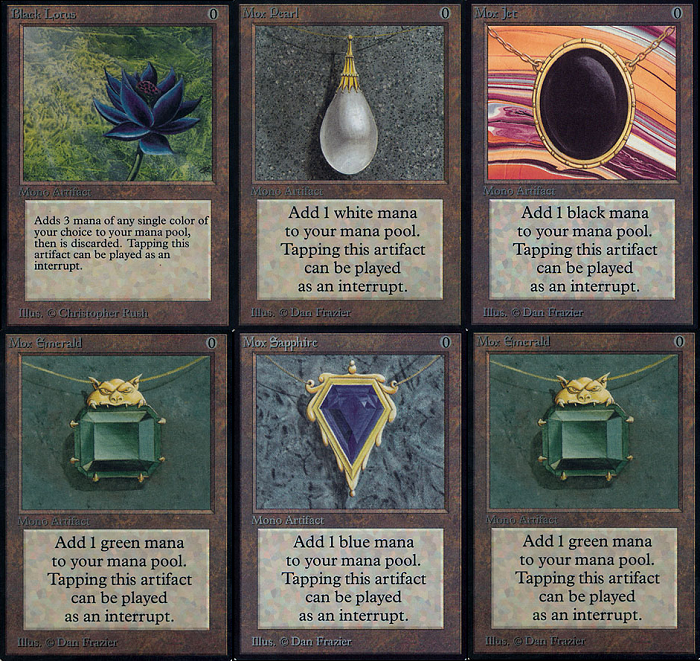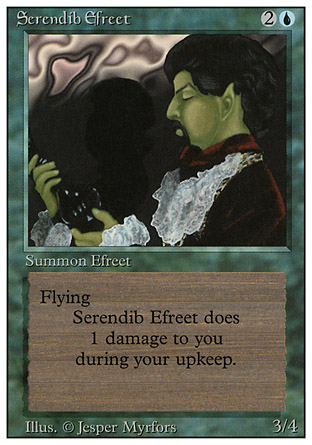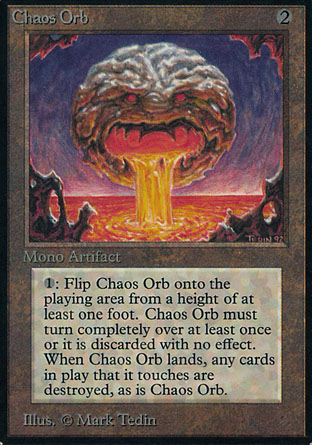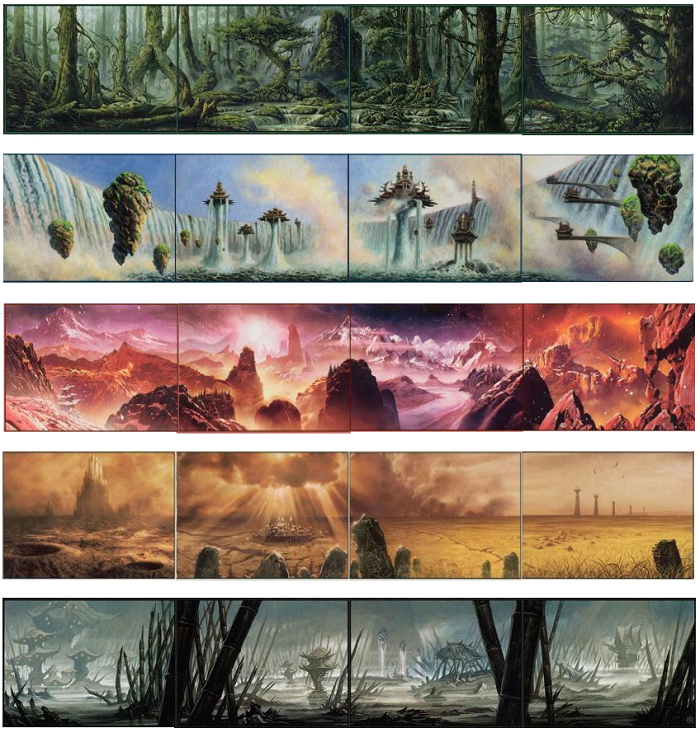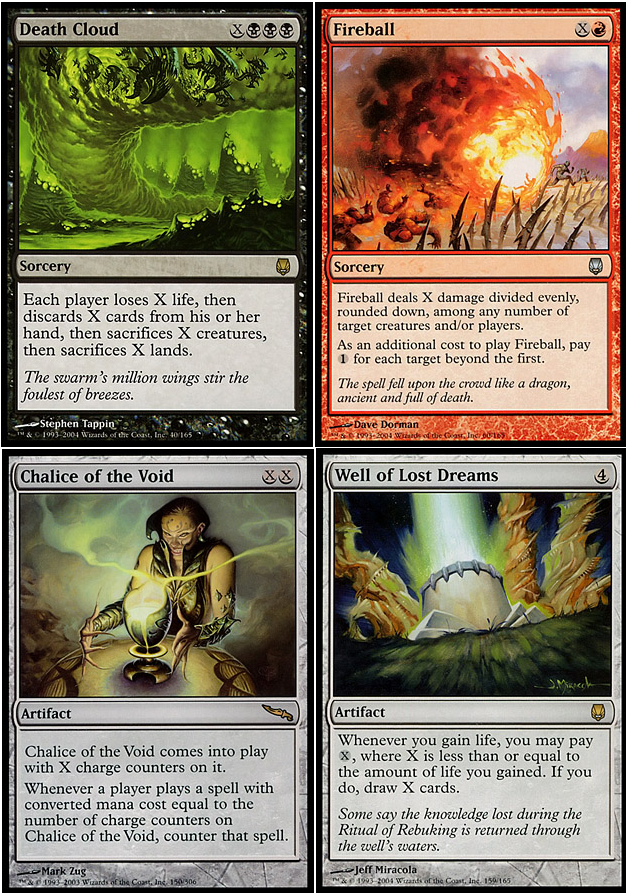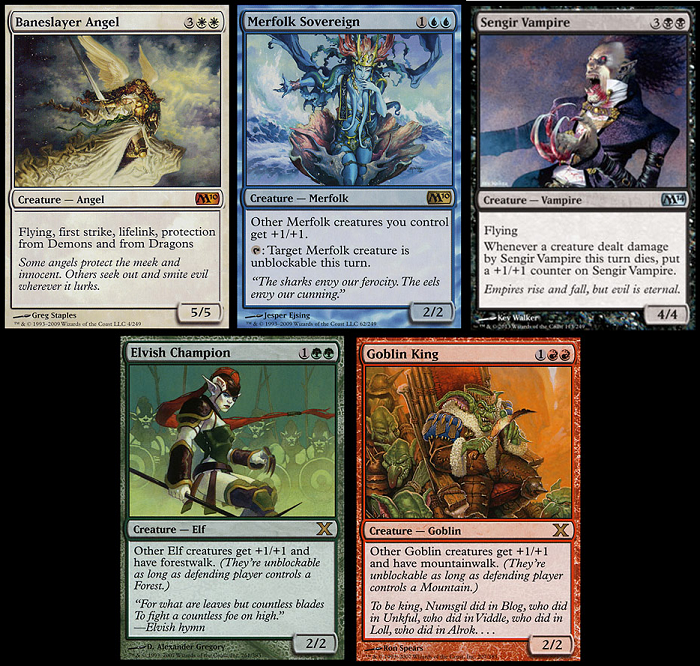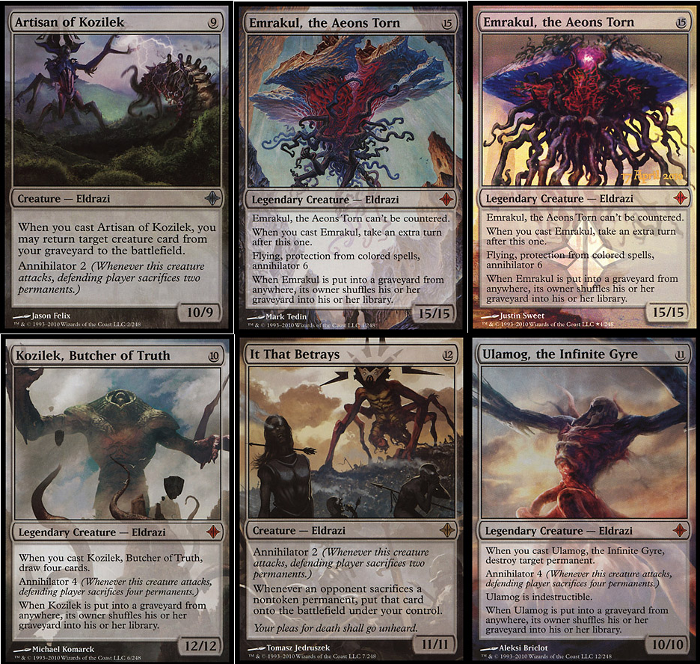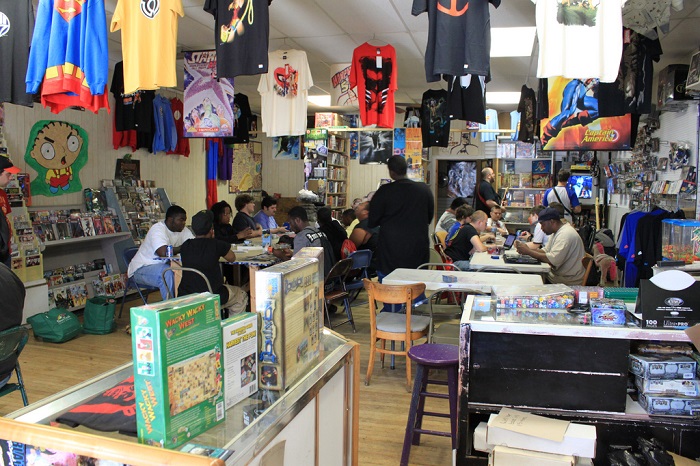
Friday Night Magic at Earth 383
20 years ago this month, I introduced my college friends to a new concept, the collectible card game (CCG). Magic the Gathering was instantly addictive for all of us, a game one part role-playing, one part exploration and discovery, and ten parts ingenuity. I’ll never forget when my friends confronted me after a few weeks of play, demanding, “Why did you keep this from us for so long?”
Truth is, I had just discovered Magic a few months earlier when I found a couple of friends playing in their apartment. A game where you play a Wizard (excuse me, “Plainswalker”) collecting spells and creatures into your spellbook to use against other opponents? Sold.
We lived on the East Coast, so the closest we got to the Alpha, Beta, Arabian Nights, and Antiquities sets were a smattering of commons that we prized in our collections. For a decade of play, the closest I got to seeing a Black Lotus card, the most prized card in the MTG history, was a counterfeit our local comic shop accidentally bought.
I remember the summer of 1994, eagerly awaiting Legends and The Dark expansions. We got to the hobby shop a half hour after they opened each time, managing to get the last three packs of Legends in June and the last five of Darkness in August. The game was selling out so fast.
The cons were being swept up in the excitement too. In addition to the comics, movies, artwork, costuming (we didn’t call it cosplay back then), and Japanamation (before we called it the more politically correct “anime”), we now had sealed deck Magic tournaments.
We also didn’t have much of a World Wide Web back then, so we thrived on word-of-mouth and urban legends. One of my favorites was the stories of players tearing up their Chaos Orbs in competitions to scatter the pieces all over their opponent’s cards. The rumors and fantasies lent to the mystical feel of the game.
Fast-forward ten years later, and I’m getting sucked back into the game with the Kamigawa Block, an Asian-themed expansion, and there is now a weekly event called Friday Night Magic (FNM), where dozens of adults and kids were gathering to play in a tournament that would often run until two in the morning. With the World Wide Web, the diversity of deck designs were now being reduced to a few NetDecks, deck designs that were proven to work. A favorite at this time was the Ravager, and you would hear the words, “Sack it to the Ravager,” all night long until the cards rotated out of play.
I helped out with the tournaments, often running them. This made me a defacto judge despite being one of the worst players at the shop. I would tell my opponents at the end of the night, “Wow. You must have done really poorly to be playing me.” Judging for me was easy though as the rules were printed on the cards, you just had to read them out loud and do what they said.
The Educational Dimension of MTG
Reading comprehension and mathematics are the core skills you must have to be a decent Magic player. I started a Junior Magic league at the shop, where I gave out the excess cards the pros were practically throwing away.
Word problems and Verbal Acuity
Unhinged was a gag-edition of Magic, one whose cards couldn’t be mixed into normal play, but it best captured the verbal tricks and need for reading comprehension in the game. Unhinged is Magic on crack, but the seal-deck tournaments of this I participated in were some of the entertaining, most mind-bending games ever.
Algebra
I realize these cards by themselves aren’t really algebra. If X can be anything you want, then it’s just whatever value you assign to it, but in the context of the game, X becomes something for which you must solve. I know X represents the number of cards I want my opponent to discard, amount of damage to deal, life to gain, or life to drain, but in the context of the game, solving for X means solving for what effect I wish to achieve. Do I want to reduce my opponent’s life to zero or less than zero? How much mana do I need to leave at the ready for other spells and effects I might need to play? It’s not just X, in Magic everything is a variable.
Statistics and Probability
This block quote captures it best:
In many ways, deckbuilding in Magic is an equally vexing process. We add an extra Island here, a fourth copy of Cunning Wish there, and we hope that the change will help us, but it’s very difficult, except in certain degenerate cases, (such as an Intuition for three copies of the same card,) to know with any degree of certainty whether you’ve actually made the right choice. This is because the sample size of our games is so very small. Consider that in a 60-card deck there are roughly 2 trillion opening hands you can draw, and that’s before turn one!
Then you have to account for the effects of things like fetch-lands, cards that target and pull lands from you deck and how they lower the probability of pulling lands later. I highly recommend this article if you are statistics geek and a Magic player.
Exponential Growth
One of the few decks I made that actually got me into a FNM top-two was when I figured out how to exploit the growth potential of hondens, where each shrine doubles, triples, quadruples, and pentuples your ability to heal, do damage, produce creatures, draw cards, and mill your opponent. Most players wouldn’t touch the concept because it required playing all five colors and taking on the statistical probability of getting mana-screwed, but I made it work with lots of land-pulling strategies.
Complex Problem Solving
Combine the addition, subtraction, multiplication, division, algebra, statistics, and word-games in what you can do with the cards, all together Magic becomes a game of complex problem solving. Like chess, children can play the game, but the play allows for masterminds to flourish. The game is Turing Complete, meaning you could use the cards as a machine that could perform any computation; in other words, you could make a computer out of combinations of Magic cards.
Player Culture
With 23,000 cards in existence, one of my favorite characteristics of Magic is that you are guaranteed to see something new with each new player you meet. Once upon a time, there were awesomely-powered cards that no one could get ahold of, like the Legends, but then Wizards decided to keep making more awesome cards. Big monsters stopped being doom-bringers, and became more of a liability.
Plus Wizards figured out that having the legality of cards rotate over time was a good way to keep play fresh and new. I was so happy to see the Ravager go away, making room for new innovative deck styles. Newer players are also great, they like to build fun decks out of vampires, goblins, merfolk, elves, zombies, demons, angels, illusions, soldiers, slivers, beasts, and the many other creature types from the past 20 years.
Type I tournaments were interesting too. Cards don’t rotate out of this tournament style, and, even though I got completely crushed in every match, I also got to see amazing decks from Magic history. As a fan of goblins, I enjoyed seeing how quickly the Goblin Piledriver deck would splat me with a collection of cards that runs over $300 on ebay today.
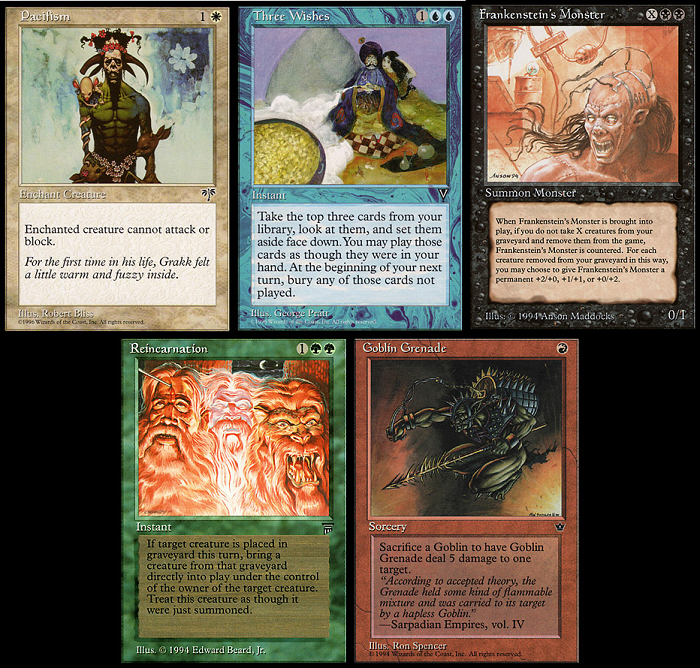
Beautiful Ideas
There were also the surprises, like one non-netdeck a player called “Mana Chickens of Death”, where he took a very tiny creature and pumped it up into something invincible. He won many tournaments at our local shop with it, beating out the decks designed by the professionals. Watching this deck at work was like watching David and Goliath.
Play Styles
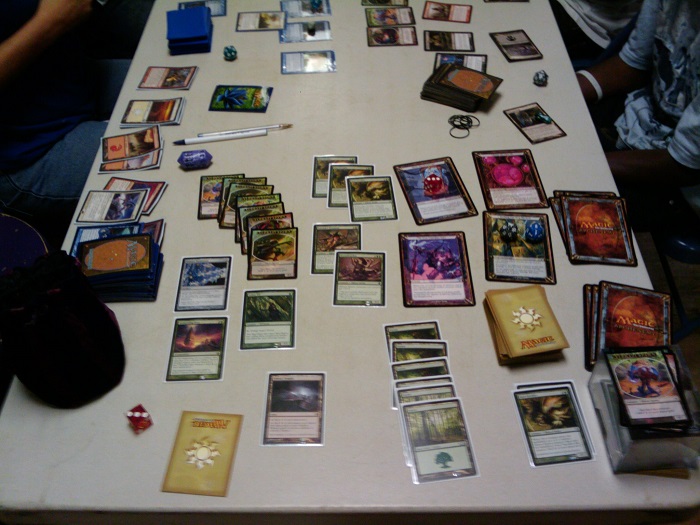
Archenemy
The diversity of play in Magic extends beyond the PvP to a wide variety of multi-player formats, making it a great social game as well. Here’s some of my favorite variations of play that supports multiple people:
Archenemy: This edition came out a few years ago, and it is hands-down the best way to introduce new players to Magic. The Archenemy cards turns one player into a super-villain, and everyone else is trying to take them out. I love playing the bad guy, whipping out cards of doom each round, while the other players, working as a team, will share cards and strategize against me. To make this version of the game more fun for everyone, we include a rule that the bad guy can’t kill a player until everyone on the team is at five life or below.
Sealed Deck: Everyone buys a starter deck and two booster packs and builds a 40-card deck out of what they get. It’s a great equalizer since it eliminates the Mr. Briefcase effects of some players having the advantage of simply having a larger collection on which to draw. We’ve added some drama to this format by having everyone ante up a random card each match, resulting in some decks becoming unplayable if you let the matches go on long enough.
Draft: Same equalizing effect as sealed deck, but allows for a little more skill over luck. In this version, everyone buys three boosters and one-by-one opens a pack, takes a card from it and passes it to the right or left. You get to build a targeted deck out of what you find in the packs, but you also have to fight the urge to pull all the rare cards out and keep them for your personal collection after the game.
Empire: This is a good version that involves team play. Has to be at least six players, with each team making up two soldiers and an emperor. The idea is to kill at least one soldier and take out the leader to win.
Five-point Star: My favorite and one that makes people do double-takes when I suggest it. Can only work with five players who sit in a five-point star. The first player to take out the two opponents directly across from them wins. Makes for some really interesting dynamics as the two players to your immediate right and left are your allies, but they are each allied with one of your enemies. Plus an ally can turn against you if they want to keep you from winning the game. To make this even better, have each player take a color and sit them according to the color arrangement on the back of a Magic card.
The Future
Magic is best flavored for me when it includes literary or mythological references, and the early sets were great for this, but not so much the later sets. Magic explored new an alien fantasy worlds, and that was fun, but I’m also thankful for the Asian myths of the Kamigawa block, from which I learned much. This month marks the release of Theros, a magic block themed on Greek and Roman mythology. Awesome sauce.
With two young kids and a demanding job, I’m unable to spend hours at the local gaming shop enjoying in person play. So I was super jazzed to find Magic 2014 Duels of the Plansewalkers, a video game version of Magic that actually plays great for casual engagement (even if they need to hurry up and fix multi-player for Android). It’s still a hobbled form of the game, because MTG is a social phenomenon, but it’s a methadone substitute until I can introduce my sons to this wonderful wonderful game.
